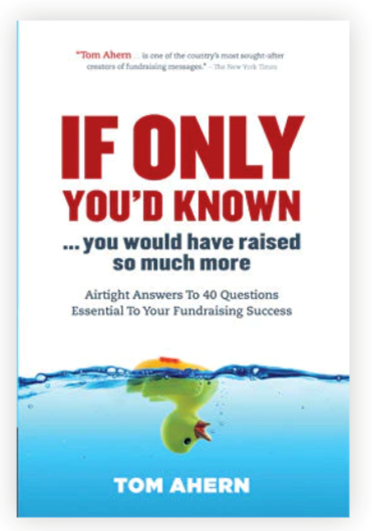The following is a hand-picked guest post from Lisa Sargent. Enjoy, and you can read more about Lisa below.
* * *
As a fundraising copywriter I get asked a lot about strategy.
“How often should we communicate with supporters?”
“Is mail really better – or email?”
“What if our nonprofit can’t do the thing you suggest?”
For all the advice around strategy, you still have foundational questions. And you’re hoping for actionable, achievable answers. Fear not! Today we’ll get real-world answers to my most asked questions – sized for every organization – to help you grow your donor fundraising and retention communications.
Let’s dig in.
Question 1: What should an effective donor communications calendar look like for my nonprofit?
Answer:
First, let me say: I get what you’re facing. Everywhere you look, it feels like someone is telling you that you’re mailing too much or not enough, or the wrong stuff. But no one is sharing what a working (and workable), effective, sustainable, real-life fundraising calendar looks like. It’s time we change that.
I call this basic strategy the “dead simple donor comms calendar.”
Yes, there are variations. (After the basic plan, below, you’ll find two alternatives.) Yes, you may need to adapt these plans depending on the maturity of your donor communications program, the timing of milestone dates/events in your nonprofit, and the capacity/skillset of your fundraising team.
But this entry strategy is a great goal to work towards and, for the record, one of the plans my clients often use.
Basic 3X3 Donor Comms Calendar: [3 newsletters/3 appeals + reminder]
Approx. size of organization working this plan: $3 million+; 2-3 person team (**see Note2)
Jan/Feb: Donor newsletter
Apr/May: Appeal
June: Donor newsletter
Sept: Appeal
Oct: Donor newsletter
Nov: Holiday Appeal
Dec: Holiday Reminder
Extra Mailings (*see Note1)
My design partner Sandie (aka Designer Sandie) and I have used variations of this to help clients achieve successes such as:
- an organization that grew its active donors from 2,000 to over 20,000 (increasing to a nearly 70% retention rate),
- a nonprofit that grew its direct marketing income six-fold,
- another that routinely saw 10+ percent response rates to newsletters,
- another that cross-purposes its comms to attract new supporters, encourage legacy gifts, and promote new services.
*Note1: You will have other pieces happening at the same time. You may be modifying your calendar to incorporate other, special appeals. Bespoke TYs – custom-crafted to each appeal and newsletter – are built into these plans. For today, you’ll see these “extra” pieces labeled as Satellite Mailings at the end of each calendar.
**Note2: When I talk about the team, I mean on the client side. In my case, the other part of the team is me and Designer Sandie, plus the printer of choice [or print management company, etc.] our clients work with.
Here’s a second donor comms plan, one of the variations I mentioned a moment ago, a slightly expanded calendar…
4X4 Donor Communications Calendar: [4 newsletters/4 appeals + reminder]
Approx size of organization working this plan: Approx $8mil organization; 3+ person fundraising team (+ temp helpers for holiday)
Early Feb: Thank-You Newsletter
March: Special Services Appeal
April: Spring Newsletter
June: Summer Appeal
July: Newsletter [includes special gratitude premium]
September: Autumn Appeal
October: Autumn Newsletter
November: Holiday Appeal
December: Holiday Reminder
Extra Mailings (*see Note1 at basic plan above)
And here’s another for a larger organization, that incorporates multiple special mailings and replaces one of the newsletters with a stewardship mailing:
Expanded Donor Communications Calendar: [3 newsletters/Specialized packs and multiple appeals]
Approx size of organization working this plan: Approx $20mil+ organization; 6+ person fundraising team
Jan: Winter Newsletter
Feb: Tax Mailing
Mar: Special Appeal
Apr/May: Spring Newsletter
June: Summer Appeal
July: Supporter Survey Pack and Survey Follow-Ups
August: Summer Newsletter
September: Autumn Appeal
October: Special Stewardship Mailing
October: Tax Reminders
November: Holiday Appeal
December: Holiday Reminder
Extra Mailings (*see Note1 at basic plan above)
Hopefully this glimpse into real-life communications plans shines a light for you on how to chart your own donor communications strategy – and feel confident doing so!
Question 2: Which is better – email or mail? (The answer everyone wants to know!)
Fast answer: tl;dr – The answer is both, whenever you can.
Full answer [with side story and statistics]:
Not long ago in response to my LinkedIn post about print and older eyes, a nonprofit consultant who is over age 50 – they said so, fyi – wanted me to know “older givers” are tech savvy too. So why was I STILL talking about print? They wanted me to know they immediately throw away everything that comes from nonprofits in the mail!
The answer I gave became a feature article called How to Write for Older Donors, in my newsletter. And, so you know, I also use tech and am over age 50… and I advocate for print (direct mail) because results prove me right.
For today I want to share an excerpt from Chapter 4 of my book Thankology,which looks at why the answer to the email vs. mail question is always “Do both, whenever you can.” (fyi: all nonprofits described in the previous section on donor comms calendars do digital and direct mail, even the smaller nonprofits).
>> Statistic 1: The effect of adding a communications channel***
Read as: What can happen when you add mail to an email-only program; or add email to a mail-only program:
A study of 2,000 nonprofits that ran from 2016 to 2019 and published in the Network for Good whitepaper, Our Digital Dilemma, found “a strong relationship between donor retention and consistent multi-channel engagement,” including:
“Nonprofits that increased the number of channels used to engage donors [from one channel to 2+] retained 11.89% donors year-over-year.”
>> Statistic 2: The effect of removing a communications channel***
Read as: What can happen when, for example, a decision is made that “no one wants print” and nonprofit moves from a mail/email combo program to only email:
“Conversely, nonprofits who were using a multi-channel framework but reverted to single-channel saw their median year-over-year retention drop by 31.32%. (A join Virtuous/NextAfter study of 119 nonprofits showed mult-channel donors give 3X more, too.)”
***Note for Statistics 1 and 2:
Network for Good is now Bonterra. I’ve searched for a new link to the Digital Dilemma whitepaper and can’t locate one. If I find it, I’ll update everyone in a future Loyalty Letter. You can, however, get the 2021 Virtuous/Next After study on free sign-up, here: https://www.multichannelnonprofit.com. The study also found that for “donors who give both offline and online…their first-year donor retention rate is two times higher.”
To sum up?
Based on the research, and results we’ve seen over the years, the best answer is that if you want to keep your donors connected and giving, you’ll do both: digital and mail.
Question 3: For email vs. mail, what about thank-you letters? Do I send both? (What I told L.)
Below is the full text of the question that L. – a reader from a small nonprofit in the UK – wrote me about what to do if she can’t afford to mail everyone thank-yous, and needs to use email-only for some:
L. wrote:
As a small charity, with no real advice to hand, I am really focussing, at the moment, on creating and writing top notch Thank You letters to our donors. The one thing that perplexes me most is whether to email or write a letter and at what level of giving a letter is more appropriate or whether it is entirely acceptable to just send emails (bearing in mind the cost of postage in the UK is absurd).
Here’s my answer to L.:
If donors come to you via online donations, remember you need some kind of disclaimer that mentions you’ll communicate with them by post. (You want the option to do this.)
Gift acknowledgment may fall into the ‘administrative communications’ gray zone for charity regulations, but I’d check those rules first if you haven’t. It’s super easy to add a notice to your donation page, by including a variation of this wording below your opt-in boxes online (again run past your legal team or check charity regs first):
We’ll also keep you updated by post. You can update your communication preferences any time at [link to full email of donor care for your org here]. And for more information you can see our privacy statement here.
Then, for each appeal and newsletter, you can craft one version of a thank-you (TY) for post (mail), and one for email. All of my nonprofit clients send post and email TYs to every supporter who gives (and has given permission to contact). The reason for this is gratitude and acknowledgment firstly, and secondly because we know when donors give by more than one channel (online/post e.g.) they give longer and stronger (see data in Question 2).
With that said, knowing your charity is still small and growing, you could tier who receives both post and email TYs, and who receives email-only.
You’ll know your donors best. But for example, you might consider:
- all new donors get both,
- all monthly givers get both when they sign up
- repeat givers (so, second gift especially which is huge in importance, and beyond if you can)
- donors who give over a certain threshold/and loyal givers
- tax-efficient givers
- in memoriam/tribute givers, in-mems especially who we know have a connection to legacy.
Have a think on thanking these donors with an eye towards stewardship and retention, then as your organization grows, you can consider bringing more people into the double-thank-you strategy.
I went on to refer L. to my thank-you clinic on SOFII, free, no sign-up needed, gateway article here: https://sofii.org/article/how-to-write-a-better-thank-you-letter-and-why-it-matters
Question 4: My head is spinning. Can you leave me with one suggestion to act on for today?
Answer: Yes! Spool up on – and start drip feeding across your communications – the opportunity to give through legacy donations.
By this I mean: Help show donors how they can leave a gift to your organization in their will.
You’ll find tips on overcoming common bequest giving barriers – plus super easy ways you can start to incorporate legacy giving in your messaging, right here in my blog post, Legacy Logjams and How to Free Them.
The simplest of all? Get a legacy checkbox on your reply form (donation slip, reply device, etc.) It has not, for us, suppressed response to appeals, just so you know.
You can keep it simple:
[ ] Please send me details on how I can remember the work of [your charity’s name here] in my Will.
OR add emotion:
[ ] I’d like to leave a legacy of love – please post free details to me on how I can leave a gift in my Will to [remember homeless pets, advance breast cancer research, etc].
One of our clients saw their first legacy donation about 18 months after we added these. We can’t prove this made the difference, but they had never mentioned legacy giving to their donors before that.
* * *
© Lisa Sargent and Lisa Sargent Communications, used with permission. If you adapt or repurpose this content in any format, please be a guardian of good karma and get your proper permissions. And, of course, remember that this information is provided for informational purposes only, and should not be considered as legal advice on any subject matter.
Steven says: “Lisa Sargent is a fundraising expert and the author of Thankology, the best book on thanking donors that I’ve ever read. You can (and should!) subscribe to her newsletter here.”
Lisa says: “If this mini-strategy session helped you, you can:
Subscribe to my Loyalty Letter newsletter for fundraisers
Connect/follow/say hello on LinkedIn
Check out Thankology (on Amazon or Bookshop)
Find free fundraising resources at lisasargent.com
“Thank you for reading today, and big thanks to Steven, Jim, and The Better Fundraising Co. for sharing a place on their blog.“











